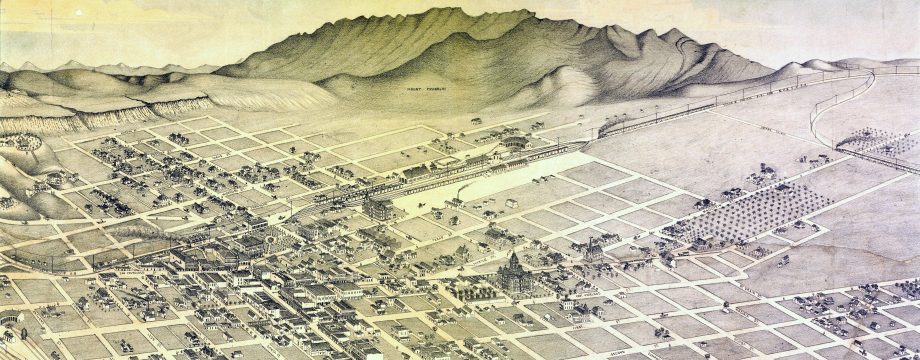We’re back from the American Historical Association and had a wonderful time! This essay is the first installment in a series covering panels we wanted to share with you, our dear readers. -ed
After my first day at the AHA, I met up with Brandon Morgan, one of our colleagues at the blog, who was presenting on a panel with the intriguing title, “Utopian Visionaries, Exiles, and Other Stateless Peoples in the Americas.” Over dinner at the Sheraton with a group of friends, I talked with Brandon and two of the other panelists, Travis E. Ross and Julian Dodson, about their work. I decided to attend their panel the next day.
Following an introduction of the panelists by Colin Snider (University of Texas at Tyler), Travis Ross, who recently defended his dissertation at the University of Utah, discussed his work on the identity of the nation-state in the context of historical memory, studying nineteenth-century interviews of residents of Alta California. One of the points that struck me most was that although ethnic Mexicans and Anglos disagreed on many things about society and politics in the state, they shared common ground with the regional identity of Alta California.
Travis´s research uncovered how people who had lived in Alta California before its transfer to the United States worked hard to maintain their community identity as revolutions and other political unrest threatened this reality. Irrespective of which government was in charge, locals wanted to protect the distinct identity of Alta California. Nevertheless, as new waves of gold rushers and other Anglos flooded into this space, this fight was unsuccessful as most of the Californios, Spanish-language residents who had lived in Alta California under Spanish and Mexican rule, lost everything after California gained U.S. statehood.
Brandon Morgan, who works at Central New Mexico Community College, continued the panel discussing his work on Mormon exiles in Mexico during the late nineteenth century. He described the Edmunds-Tucker Act of 1887 and its aggressive prosecution of Mormons in the nineteenth century over polygamy. Mormons believed the legal proceedings to be a miscarriage of justice and felt that the government not only wanted to punish polygamy, but also eliminate their religion.
In response, some coreligionists decided to relocate to Mexico, establishing settler communities they called “colonies” to continue to practice their religious beliefs without interference from the U.S. government. Brandon argues that by crossing the border Mormons gained the status and economic power that had eluded them in the United States. In doing so, they also reasserted their claim to whiteness, and largely remained separate from the local community even as they benefited from policies of the national government under Porfirio Díaz, which permitted them not to pay certain duties.
Finally, Julian Dodson (Washington State University) studies the social networks that Mexican exiles formed across the U.S. southwest in the early twentieth century. He finds that in exile the political enmities that divided these groups against one another in Mexico largely evaporated once they relocated north of the border. Julian identified the exiles as the “revolution’s losers,” highlighting how they were reviled in Mexico as members of a defeated elite that had benefited from Díaz’s long rule (1876-1911). Across the border, the exile community was sustained on a healthy diet of rumors and conspiracies about the new revolutionary government as it asserted its power. Moreover, the exile community took on a diverse characteristics as members of different failed rebellions and counter-revolutions also headed north to escape their enemies.
Julian described the formation of these exile groups, noting that militant Catholic activists played an important role. They cultivated contacts with military figures who supported the exiles during times of political unrest. Members of the Catholic contingent also operated as intelligence brokers between Mexican officials and the exile community. Later, as the revolution transitioned into its state-building period after 1920, opposition to the political strongman and president, Plutarco Elías Calles, who was a committed anti-Catholic leader, helped to unify aspects of the exile community.
Afterwards, Colin read the observations written by José Angel Hernández (University of Houston) who served as commenter, but was unable to attend. José Angel provided excellent constructive critiques of the work presented, urging the panelists to more clearly identify how the subjects were stateless or to consider using a different concept to identify them. In the audience discussion, someone asked whether location reflected exiles’ loyalties. Julian responded affirmatively, explaining that Catholic exiles tended to go to San Antonio and El Paso, whereas Callistas went to San Diego and Los Angeles. Meanwhile, Huertistsas went to Tucson and also had ties with Los Angeles.
As the discussion continued, Travis posed a question for his other panelists. He acknowledged the difficulty in defining the people in their work as stateless, and wondered about other ways to conceptualize these subjects. Julian said that, perhaps, the idea of “statefulness exiles” rather than stateless exiles was more applicable, emphasizing that the networks these groups formed attempted to take advantage of state ties at different times and in different contexts. Moreover, a point that Brandon and Julian agreed on was that while these exiles lived in states freely, they were to a certain extent out of reach, defying law enforcement in their home countries.
Brandon concluded, saying that Mormon colonies in the late nineteenth century were trying to use policies in Mexico to their benefit, while maintaining ties with the United States. This strategy gave them some choice about identity. For instance, Mormons who naturalized has Mexicans had begun to take up the role of jefe politico in their locality. Many Mormons viewed their time in Mexico as sojourners, ready to return to the United States once the problems had been resolved politically.

